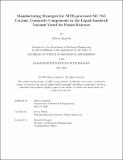Manufacturing Strategies for NITE-processed SiC/SiC Ceramic Composite Components in the Liquid Sandwich Vacuum Vessel for Fusion Reactors
Author(s)
Agarwal, Shreya
DownloadThesis PDF (8.953Mb)
Advisor
Woller, Kevin
Terms of use
Metadata
Show full item recordAbstract
In nuclear fusion tokamaks, vacuum vessels must be able to withstand large disruption forces resulting from potential plasma quenches. The Liquid Sandwich Vacuum Vessel (LSVV) is a novel alternative to conventional thick steel vacuum vessels. In the LSVV design, liquid lead circulates through channels within thin walls made of silicon carbide ceramic composite (SiC/SiC). By dissipating disruption forces within the liquid lead, the SiC/SiC walls can remain thin, improving heat transfer and the overall efficiency of the fusion reactor. However, SiC/SiC’s brittleness and anisotropy present challenges in machining and manufacturing. A literature review explores existing strategies for manufacturing, machining, and joining SiC/SiC components within the nuclear fusion context. A manufacturing plan is proposed for the fabrication and joining of tubular components and walled structures with integrated channels, aiming to further SiC/SiC manufacturing capabilities for the LSVV design. Further research is necessary to develop and validate robust manufacturing and joining methods specific to the LSVV application.
Date issued
2024-05Department
Massachusetts Institute of Technology. Department of Mechanical EngineeringPublisher
Massachusetts Institute of Technology